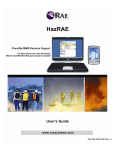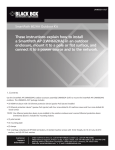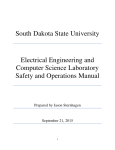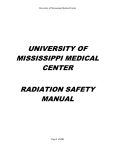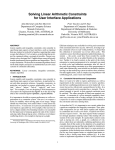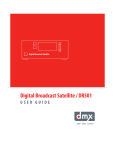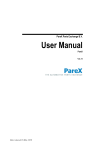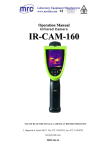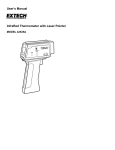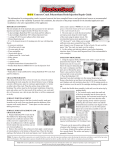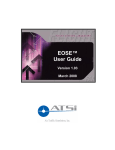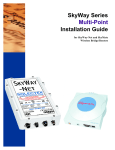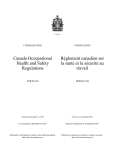Download Guidelines - Nunavut Research Institute
Transcript
Page |1
Laboratory User Manual: Nunavut Research
Institute/Environmental Technology Program
November 2014
Table of Contents
General Lab Use Rules ......................................................................................................................... 4
Before Leaving the Lab Make sure to: ................................................................................................. 5
Eye Wash Stations ............................................................................................................................... 6
1.
Preparing the Station for Use .................................................................................................... 7
2.
Length of Rinsing Time .............................................................................................................. 7
3.
Keeping the Eyes in Contact with Rinse ..................................................................................... 7
Laboratory Fume Hoods ...................................................................................................................... 8
Personal Protective Equipment........................................................................................................... 9
Eye Protection ..................................................................................................................................... 9
Hearing Protection ............................................................................................................................ 10
Lab coats ........................................................................................................................................... 10
Hand protection ................................................................................................................................ 10
In case of emergency Notify: Rick Armstrong TEL: 867-979-7280
FIRE DEPT: 979-4422 AMBULANCE: 979-4422 HOSPITAL: 975-8600
POISON CONTROL: 1-888-255-1010
Page |2
Latex gloves and skin reactions .................................................................................................. 11
Glove selection guidelines .......................................................................................................... 11
Selection, use and care of protective gloves ............................................................................... 12
Control of Chemical Hazards ............................................................................................................. 15
3.2 Flammable chemicals ........................................................................................................... 15
3.3 Oxidizing chemicals .............................................................................................................. 15
3.4 Reactive chemicals ............................................................................................................... 16
Corrosive chemicals ................................................................................................................... 16
Emergency Procedures Guide ........................................................................................................... 17
First aid ...................................................................................................................................... 17
Burns ......................................................................................................................................... 18
Burns to the skin ........................................................................................................................ 18
Burns to the eyes ....................................................................................................................... 18
Cuts............................................................................................................................................ 19
Needlestick injuries .................................................................................................................... 20
Chemical splashes to the skin or eyes......................................................................................... 20
Poisoning ................................................................................................................................... 20
Fire Prevention and Response........................................................................................................... 21
The fire triangle.......................................................................................................................... 21
Classes of fire ............................................................................................................................. 22
Fire extinguishers ....................................................................................................................... 22
Clothing Fires ................................................................................................................................. 24
Responding to Chemical Spills........................................................................................................... 24
Flammable and toxic liquids ....................................................................................................... 24
Corrosive liquids ........................................................................................................................ 25
Corrosive solids .......................................................................................................................... 25
Toxic solids ................................................................................................................................. 25
Gases ......................................................................................................................................... 25
Mercury ..................................................................................................................................... 26
Labeling and Storage of Chemicals and Samples............................................................................... 27
In case of emergency Notify: Rick Armstrong TEL: 867-979-7280
FIRE DEPT: 979-4422 AMBULANCE: 979-4422 HOSPITAL: 975-8600
POISON CONTROL: 1-888-255-1010
Page |3
Chemical Labeling ...................................................................................................................... 27
Labeling ..................................................................................................................................... 27
General Storage Guidelines ........................................................................................................ 28
Ergonomics ................................................................................................................................ 28
Chemical Storage ....................................................................................................................... 29
Flammable liquid storage cabinets ............................................................................................. 29
Chemical compatibility ............................................................................................................... 30
Flammables ................................................................................................................................ 32
Non-flammable solvents ............................................................................................................ 32
Acids .......................................................................................................................................... 32
Caustics ...................................................................................................................................... 32
Water reactive chemicals ........................................................................................................... 32
Oxidizers .................................................................................................................................... 32
Non-oxidizing compressed gases ................................................................................................ 33
Oxidizing compressed gases ....................................................................................................... 33
Non-volatile, non-reactive solids ................................................................................................ 33
Managing Laboratory Wastes ........................................................................................................... 36
6.1 Waste minimization ............................................................................................................. 36
In case of emergency Notify: Rick Armstrong TEL: 867-979-7280
FIRE DEPT: 979-4422 AMBULANCE: 979-4422 HOSPITAL: 975-8600
POISON CONTROL: 1-888-255-1010
Page |4
General Lab Use Rules
1)
No unauthorized or unsupervised personnel are allowed in the laboratory
2) NO Smoking, NO Eating, NO Drinking in the lab, and no storing of food or drink
anywhere in the lab.
3) Safety glasses (or regular glasses) and lab gloves MUST be worn at all times.
4) No Unnecessary activity (horseplay, running, etc.)
5) Closed-toe shoes must be worn at all times (i.e. no open shoes or sandals).
6) Long hair must be tied back
7) No applying make-up, lip balm, or handling of contact lenses.
8) Lab coats also should be worn when working with chemicals or infectious
materials. Other personal protective equipment and clothing may be required for
certain lab work
9) Only work with chemicals or other toxic or flammable materials in a functioning
fume hood
10) Keep the workspaces clean and free of unwanted chemicals, specimens and
equipment. Do not leave bottles of chemicals or samples, empty or full on the
floor.
11) Keep laboratory doors closed at all times
12) No children or pets allowed in the lab.
13) No Unauthorized use of equipment allowed.
14) Do not block access to emergency equipment (eye wash stations, first aid kits,
etc.) or to doors and passage ways
15) Review Material Safety Data Sheets (MSDS) and container labels before moving,
handling, or opening chemicals. Keep copies of the MSDS accessible at all
times while working with chemicals. Work only with chemicals once you know
their hazards (flammability, toxicity, and reactivity), how to handle and store and
dispose them safely, and emergency procedures for spills.
16) Keep chemical containers closed when not in use so contents cannot evaporate
or escape a tipped container.
In case of emergency Notify: Rick Armstrong TEL: 867-979-7280
FIRE DEPT: 979-4422 AMBULANCE: 979-4422 HOSPITAL: 975-8600
POISON CONTROL: 1-888-255-1010
Page |5
17) Label all chemical containers according to chemical contents and concentrations
and store chemicals only in designated storage units. Refer to Refer to MSDS
for further info on safe storage for particular chemicals.
18) Never pipette by mouth; use mechanical transfer devices
19) Report accidents and dangerous incidents to your supervisor immediately.
20) Report all spills (including water) to the supervisor immediately; clean the spill
only if you are trained and able to do so.
Before Leaving the Lab Make sure to:
1) Turn off any water and any equipment used for lab work (e.g. fume hoods).
2) Turn off gas, vacuum and compression lines and heating apparatus (if in
use)
3) Return unused materials, equipment and apparatus to their proper storage
locations
4) Label, package and dispose of all waste material properly. Do not dispose
of chemicals down the drain. Only dispose of chemical wastes according
to guidelines and if trained to do so.
In case of emergency Notify: Rick Armstrong TEL: 867-979-7280
FIRE DEPT: 979-4422 AMBULANCE: 979-4422 HOSPITAL: 975-8600
POISON CONTROL: 1-888-255-1010
Page |6
5) Dispose of broken glass and discarded sharp objects only in designated
containers.
6) Remove defective or damaged equipment immediately, and arrange to have
it repaired or replaced
7) Thoroughly clean with bleach any equipment or work areas that may have
been in contact with hazardous materials.
8) Discard used gloves, return other protective clothing (lab coats and glasses.) to
storage locations and wash your hands thoroughly
9) Turn off lights, close and lock the door (rear and front) to the laboratory if you
are the last one to leave
Eye Wash Stations
Emergency eye wash stations are located in areas where there is a risk of
exposure to irritants or chemicals that could damage one's eyes. Common
locations of eye wash stations include laboratories and factories.
It is crucial that a person's eyes be rinsed out immediately at an emergency eye
In case of emergency Notify: Rick Armstrong TEL: 867-979-7280
FIRE DEPT: 979-4422 AMBULANCE: 979-4422 HOSPITAL: 975-8600
POISON CONTROL: 1-888-255-1010
Page |7
wash station after coming into contact with a potentially dangerous irritant or
chemical. Eye wash stations are specially designed to deliver a constant, low
pressure stream of warm water directly to the eyes.
1. Preparing the Station for Use
o
The caps that cover the faucets should be able to be removed quickly and
easily; many eye wash stations allow these covers to come off when
turning the water flow on. The water flow should be warm and not too high
pressure. This is usually regulated by a valve attached to the unit.
The person holds their eyes open and gently places both eyes over the
faucets, one eye over each faucet. The water will directly touch the
eyeballs, rinsing irritants and chemicals out.
2. Length of Rinsing Time
o
The length of time that the eyes should be in direct contact with the water
flow varies depending on the irritant or chemical that has gotten into the
eye. A standard minimum of 5 minutes is recommended for mild irritations.
For nonpenetrating corrosives, a minimum of 20 minutes is suggested,
and for penetrating corrosives (chemicals that can go through the surface
of the eye and surrounding areas), a minimum of 60 minutes is
recommended.
It is important that those who work around the emergency eyewash station
are trained in its proper use and know the amount of rinsing time
necessary based on the type of irritant or chemical. Therefore, those
working around the station should be familiar with the chemicals used in
the workplace and know which are penetrating and nonpenetrating.
Acids are more easily rinsed out, while alkalis can be more damaging and
require a longer rinsing time.
3. Keeping the Eyes in Contact with Rinse
In case of emergency Notify: Rick Armstrong TEL: 867-979-7280
FIRE DEPT: 979-4422 AMBULANCE: 979-4422 HOSPITAL: 975-8600
POISON CONTROL: 1-888-255-1010
Page |8
o
The person using the eye wash station should continue to hold his eyelids
open with his fingers, being careful not to touch the eyeballs with the
fingers. The eyes should remain in contact with the rinsing fluid for the
entire rinsing time. It may feel unnatural to continue to hold the eyelids
open while fluid is hitting the eyes, but it is necessary to make sure the
chemicals are cleared from the eyes.
Laboratory Fume Hoods
Laboratory fume hoods are enclosed units with a sliding sash for opening or closing the hood.
They are able to capture and exhaust even heavy vapors, and are preferred for all laboratory
procedures that require manual handling of hazardous chemical material. When properly
used and maintained, fume hoods provide good protection to the user.
The NRI/ETP laboratories are equipped with Labconco Protector® Laboratory Fume Hoods
designed to allow users to work safely with toxic, noxious and other harmful chemicals. A
copy of the user’s manual must be maintained next to the fume hood at all times. Users are
required to review chapters 4 and 5 of the manual (pages 21-32) before operating the fume
hood, to become familiar with the various components, operating procedures, and safety
features. To ensure the highest degree of protection when using the fume hood please follow
these guidelines:
1. Before operating the fume hood, check to make sure that the exhaust blower is
operating.
2. Allow the hood to operate unobstructed for 5 minutes before loading with materials
and equipment
3. Avoid placing your head in the fume hood and keep hands out of the hood as much as
possible
4. Always work as far back in the fume hood as possible. It is best to keep all chemicals
and apparatus at least 6 inches inside the fume hood. Heating devices should be
placed at the rear of the hood.
5. Do not obstruct the air baffle slots in the fume hood
6. Always operate the exhaust system when using heat generating equipment in the
fume hood
7. Only materials being used in an ongoing experiment should be kept in the fume hood.
Cluttering the hood will create air flow disturbances.
8. Segregate all clean and contaminated materials while working with the fume hood
9. When it is necessary to keep a large apparatus inside a hood, it should be placed
upon blocks or legs to allow air to flow underneath.
In case of emergency Notify: Rick Armstrong TEL: 867-979-7280
FIRE DEPT: 979-4422 AMBULANCE: 979-4422 HOSPITAL: 975-8600
POISON CONTROL: 1-888-255-1010
Page |9
10. Operate the hood with the sash as low as practical. Reducing the open face will
increase the face velocity.
11. Do not lean into the hood. This disturbs the air flow, and also places your head into the
contaminated air inside the hood.
12. Do not make quick motions into or out of the hood, or create cross drafts by walking
rapidly past the hood. Limit traffic in front of the fume hood. Opening doors or
windows can sometimes cause strong air currents which will disturb the air flow into
the hood.
13. Keep hood door closed when not attended.
14. Remember that sinks inside fume hoods are not designed for disposing of chemical
wastes.
15. Perchloric acid and high level radioactive materials may not be used in this
fume hood
Personal Protective Equipment
Be aware that there are hazards associated with materials commonly used in personal
clothing. Cotton is highly permeable. Nylon, polyester and spandex are easily melted. Bodyhugging materials such as spandex will hold spilled chemicals close to the skin. Evaluate the
potential hazards of your activities and wear appropriate clothing.
Eye Protection
Eye protection is recommended at all times when working near where corrosive or toxic
chemicals are used or stored, and anywhere near high-pressure, high vacuum equipment,
near UV or laser light, or when carrying out work that can generate dusts, sprays or other
projectiles. NEVER WEAR CONTACT LENSES when working with hazardous chemicals,
In case of emergency Notify: Rick Armstrong TEL: 867-979-7280
FIRE DEPT: 979-4422 AMBULANCE: 979-4422 HOSPITAL: 975-8600
POISON CONTROL: 1-888-255-1010
P a g e | 10
unless wearing safety goggles. Vapours readily enter the space between the lenses and the
eyes via capillary action. This makes the lenses difficult to remove. If irrigation of the eye is
not performed within 15 seconds of coming into contact with certain corrosive materials,
permanent eye damage is likely to occur. Depending on the protection required during a
specific procedure, regular safety glasses, chemical safety goggles or a full face shield may
be necessary.
Hearing Protection
It is recommended that hearing protection be worn if average noise levels exceed 85 dBA
(decibels) over an 8-hour period.
Lab coats
Appropriate protective clothing (e.g., lab coats, aprons, coveralls) is required in all
experimental areas where hazardous materials are handled.
Instructions for selection and use of protective laboratory clothing are as follows:
select knee-length lab coats with button or snap closures
wear a solid-front lab coat or gown with back closures and knitted cuffs when working
with highly toxic or infectious agents
wear protective aprons for special procedures such as transferring large volumes of
corrosive material
remove protective clothing when leaving the laboratory
remove protective clothing in the event of visible or suspected contamination
Hand protection
A wide variety of gloves are available to protect against chemical exposure. Because the
permeability of gloves of the same or similar material varies from manufacturer to
manufacturer, no specific recommendations are given here. Be aware that as a chemical
diffuses through a glove, that chemical is held against the worker's hand longer and the
individual may then be more exposed to the chemical than if the glove had not been worn.
Always check to ensure the absence of cracks or small holes in gloves before each
use.
Do not wear gloves in public areas (NRI offices and classrooms). Remove gloves
before leaving the work area and before handling such things as telephones,
doorknobs, writing instruments, and laboratory notebooks.
Gloves may be reused, cleaned, or discarded, consistent with their use and
contamination.
In case of emergency Notify: Rick Armstrong TEL: 867-979-7280
FIRE DEPT: 979-4422 AMBULANCE: 979-4422 HOSPITAL: 975-8600
POISON CONTROL: 1-888-255-1010
P a g e | 11
In the laboratory, gloves are used for protection from radiation, chemical products,
biohazardous material and physical hazards such as abrasion, tearing, puncture and
exposure to temperature extremes
Latex gloves and skin reactions
Natural latex is derived from the sap of the rubber tree and contains rubber polymers,
carbohydrates, lipids, phospholipids and proteins. During the manufacturing process
additional chemical agents are added to impart elasticity, flexibility and durability to the latex.
Because of these properties, and because of their high tactile strength and low cost, latex
gloves are used for many laboratory procedures. Unfortunately, for some people, wearing
latex gloves can cause skin reactions; these can be either irritant or allergic in nature, and
can be caused by:
chronic irritation from sweating of hands inside gloves or from gloves rubbing against
the skin
sensitization to the chemical additives used in the manufacturing process
reaction to naturally-occurring latex proteins
Frequent handwashing, as well as residues from scrubs, soaps, cleaning agents and
disinfectants may further irritate the skin.
Using one of the following alternatives may reduce the risk of skin problems associated with
the use of latex rubber gloves:
non-latex gloves
"hypo-allergenic", non-powdered or low-protein latex gloves
polyethylene, PVC or cloth liners under latex gloves
non-latex gloves under latex gloves
Occurrences of skin problems (e.g., rash, itching, peeling, red, blistering skin or dry flaking
skin with cracks and sores) that seem to be associated with the wearing of latex gloves
should be reported to a physician when symptoms first appear.
Glove selection guidelines
Base selection of glove material on:
identification of the work procedures requiring hand protection
flexibility and touch sensitivity required; a need for high tactile sensitivity, for example,
would restrict glove thickness, and some protocols may require the use of gloves with
non-slip or textured surfaces
In case of emergency Notify: Rick Armstrong TEL: 867-979-7280
FIRE DEPT: 979-4422 AMBULANCE: 979-4422 HOSPITAL: 975-8600
POISON CONTROL: 1-888-255-1010
P a g e | 12
type and length of contact (e.g., occasional or splash vs. prolonged or immersion
contact)
whether disposable or reusable gloves are more appropriate
Selection, use and care of protective gloves
No single glove material is resistant to all chemicals, nor will most gloves remain resistant to
a specific chemical for longer than a few hours. Determine which gloves will provide an
acceptable degree of resistance by consulting the MSDS for the product, contacting glove
manufacturers or by referring to a compatibility chart or table for permeation data. These
resources may use the following terms:
"permeation rate" refers to how quickly the chemical seeps through the intact material:
the higher the permeation rate the faster the chemical will permeate the material;
"breakthrough time" refers to how long it takes the chemical to seep through to the
other side of the material, and
"degradation" is a measure of the physical deterioration (for example, glove material
may actually dissolve or become harder, softer or weaker) following contact with the
chemical
Guidelines for glove use include the following:
choose a glove that provides adequate protection from the specific hazard(s)
be aware that some glove materials may cause adverse skin reactions in some
individuals and investigate alternatives
inspect gloves for leakage before using; test rubber and synthetic gloves by inflating
them
make sure that the gloves fit properly
ensure that the gloves are long enough to cover the skin between the top of the glove
and the sleeve of the lab coat
discard worn or torn gloves
discard disposable gloves that are, or may have become, contaminated
avoid contaminating "clean" equipment: remove gloves and wash hands before
carrying out tasks such as using the telephone
always wash your hands after removing gloves, even if they appear not to be
contaminated
do not reuse disposable gloves
follow the manufacturer's instructions for cleaning and maintenance of reusable gloves
before using gloves, learn how to remove them without touching the contaminated
outer surface with your hands
In case of emergency Notify: Rick Armstrong TEL: 867-979-7280
FIRE DEPT: 979-4422 AMBULANCE: 979-4422 HOSPITAL: 975-8600
POISON CONTROL: 1-888-255-1010
P a g e | 13
Recommended glove materials for a variety of laboratory hazards
Trademark names were included because the reader is likely to encounter them in the
literature: consult laboratory or safety equipment suppliers, or the manufacturer, for more
information on brand name gloves. Gloves not listed here may also be suitable; refer to the
MSDS, glove manufacturer or permeation chart. The section on electricity is included for
information purposes only, as all electrical work must be done by licensed electricians.
Hazard
Degree of Hazard
Severe
Less severe
Recommended Material
Reinforced heavy rubber, staple-reinforced leather
Abrasion
Rubber, plastic, leather, polyester, nylon, cotton
Metal mesh, staple-reinforced heavy leather,
Severe
Kevlar, aramid-steel
Sharp edges
Less severe
Leather, terry cloth (aramid fibre)
Mild with delicate work
Lightweight leather, polyester, nylon, cotton
Varies depending on the Choice depends on chemical. Examples: natural,
concentration, contact
nitrile or butyl rubber, neoprene, PTFE
Chemicals and
time, etc. Consult MSDS, (polytetrafluoroethylene), polyvinyl chloride,
liquids
manufacturer or
polyvinyl alcohol, Teflon™, Viton™, Saranex™,
permeation chart
4H™, Chemrel™, Barricade™, Responder™
Leather, insulated plastic
Cold
or rubber, wool, cotton
Heat
Over 350oC
Asbestos Zetex™
Neoprene-coated asbestos, heat-resistant leather
Up to 350oC
with linings, Nomex, Kevlar™
Heat-resistant leather, terry cloth (aramid fibre)
Up to 200oC
Nomex, Kevlar™
o
Up to 100 C
Chrome-tanned leather, terry cloth
Rubber-insulated gloves
tested to appropriate
Electricity
voltage (CSA Standard
Z259.4-M1979) with
leather outer glove
General duty Cotton, terry cloth, leather
Thin-film plastic;
Product
lightweight leather, cotton,
contamination
polyester, nylon
Low to moderate
Radiation
Any disposable rubber or plastic glove
radiotoxicity
In case of emergency Notify: Rick Armstrong TEL: 867-979-7280
FIRE DEPT: 979-4422 AMBULANCE: 979-4422 HOSPITAL: 975-8600
POISON CONTROL: 1-888-255-1010
P a g e | 14
In case of emergency Notify: Rick Armstrong TEL: 867-979-7280
FIRE DEPT: 979-4422 AMBULANCE: 979-4422 HOSPITAL: 975-8600
POISON CONTROL: 1-888-255-1010
P a g e | 15
Control of Chemical Hazards
Chemicals can gain entry into the body by:
Inhalation of gases, vapours and particulate material (e.g. mists, dusts, smoke,
fumes)
Absorption through skin of liquids, solids, gases and vapours
Ingestion of chemicals directly or indirectly via contaminated foods and beverages
and contact between mouth and contaminated hands (nail-biting, smoking)
Injection of chemicals through needles and other contaminated laboratory sharps
3.2 Flammable chemicals
Flammable and combustible liquids, solids or gases will ignite when exposed to heat,
sparks or flame. Flammable materials burn readily at room temperature, while combustible
materials must be heated before they will burn. Flammable liquids or their vapours are the
most common fire hazards in laboratories. Refer to Section 5.4 ("Preventing Fires") for
specific details on the safe handling of flammable chemicals in the laboratory
3.3 Oxidizing chemicals
Oxidizers provide oxidizing elements such as oxygen or chlorine, and are capable of
igniting flammable and combustible material even in an oxygen-deficient atmosphere (Refer
to Section 5.1, "The Fire Triangle"). Oxidizing chemicals can increase the speed and intensity
of a fire by adding to the oxygen supply, causing materials that would normally not burn to
ignite and burn rapidly. Oxidizers can also:
React with other chemicals, resulting in release of toxic gases
Decompose and liberate toxic gases when heated
Burn or irritate skin, eyes, breathing passages and other tissues
In case of emergency Notify: Rick Armstrong TEL: 867-979-7280
FIRE DEPT: 979-4422 AMBULANCE: 979-4422 HOSPITAL: 975-8600
POISON CONTROL: 1-888-255-1010
P a g e | 16
Precautions to follow when using and storing oxidizers in the laboratory include the following:
Keep away from flammable and combustible materials
Keep containers tightly closed unless otherwise indicated by the supplier
Mix and dilute according to the supplier's instructions
To prevent release of corrosive dusts, purchase in liquid instead of dry form
Reduce reactivity of solutions by diluting with water
Wear appropriate skin and eye protection
Ensure that oxidizers are compatible with other oxidizers in the same storage area
3.4 Reactive chemicals
May be sensitive to jarring, compression, heat or light
May react dangerously with water or air
May burn, explode or yield flammable or toxic gases when mixed with incompatible
materials
Can vigorously decompose, polymerize or condense
Can also be toxic, corrosive, oxidizing or flammable
Some chemicals may not be dangerous when purchased but may develop hazardous
properties over time (e.g. diethyl ether and solutions of picric acid).
Follow these precautions when working with dangerously reactive chemicals:
Understand the hazards associated with these chemicals and use them under
conditions which keep them stable
Store and handle away from incompatible chemicals
Keep water-reactive chemicals away from potential contact with water, such as
plumbing, fire sprinkler heads and water baths
Handle in a chemical fume hood
Wear the appropriate skin and eye protection
Work with small quantities
Use up or dispose of these chemicals before they attain their expiry date
Corrosive chemicals
Corrosives are materials, such as acids and bases (caustics, alkalis) which can
damage body tissues as a result of splashing, inhalation or ingestion. Also:
In case of emergency Notify: Rick Armstrong TEL: 867-979-7280
FIRE DEPT: 979-4422 AMBULANCE: 979-4422 HOSPITAL: 975-8600
POISON CONTROL: 1-888-255-1010
P a g e | 17
They may damage metals, releasing flammable hydrogen gas
They may damage some plastics
Some corrosives, such as sulphuric, nitric and perchloric acids, are also oxidizers; thus
they are incompatible with flammable or combustible material
They may release toxic or explosive products when reacted with other chemicals
They may liberate heat when mixed with water
Precautions for handling corrosive materials include:
Wear appropriate skin and eye protection
Use in the weakest concentration possible
Handle in a chemical fume hood
Use secondary containers when transporting and storing corrosives
Always dilute by adding acids to water
Dilute and mix slowly
Store acids separately from gases
Emergency Procedures Guide
First aid
Know how to handle emergency situations before they occur:
Become familiar with the properties of the hazardous products used in your area.
Familiarize yourself with the contents of the first aid kit and learn how to use them.
Keep instructions readily available and easy to understand.
In case of emergency Notify: Rick Armstrong TEL: 867-979-7280
FIRE DEPT: 979-4422 AMBULANCE: 979-4422 HOSPITAL: 975-8600
POISON CONTROL: 1-888-255-1010
P a g e | 18
Locate and know how to test and operate emergency equipment, such as showers
and eyewashes, in your area (Refer to Section 1.4).
Learn first aid: Contact Environmental Health and Safety for a schedule of CSST
(Commission de la santé et de la sécurité du travail)-approved workplace first aid and
CPR (cardiopulmonary resuscitation) course dates.
The emergency first aid procedures described below should be followed by a consultation
with a physician for medical treatment.
Burns
In the laboratory, thermal burns may be caused by intense heat, flames, molten metal, steam,
etc. Corrosive liquids or solids such as bases and acids can cause chemical burns; first aid
treatment for chemical burns is described in Section 12.1.4 below. In electrical burns,
electrical current passing through the body generates heat.
Burns to the skin
First aid treatment of skin burns encompasses the following:
If the burn is electrical in origin, ascertain that the victim is not in contact with the
power supply before touching him/her. If the victim remains in contact with a power
source, unplug the device or shut off the main power switch at the electrical
distribution panel.
Dial 911 if the burn is serious. Seek immediate medical treatment for all electrical
burns, even if they don't appear to be serious.
Remove jewelry, including watches, from the burned area.
Expose the burnt area, but avoid removing clothes that are stuck to the skin.
If possible, immerse burnt surfaces in cold water for at least 10 minutes, or apply cold
wet packs.
Avoid applying lotions, ointments or disinfectants to a burn. First and second degree
burns can be washed with soap and water after the cool down period.
Cover first and second degree burns with a moist bandage; apply dry compresses to
third degree burns and to entry and exit wounds of electrical burns.
Do not burst blisters, as they form a natural barrier against infection.
Burns to the eyes
Burns to the eyes may be caused by chemical substances, heat (hot liquids, steam, open
flames, molten metal, etc.), or radiation from welding procedures, laboratory lamps and
lasers. Burns caused by ultraviolet, visible or near-infrared radiation may not produce
symptoms until 6-8 hours after exposure. First aid procedures for chemical burns to the eyes
In case of emergency Notify: Rick Armstrong TEL: 867-979-7280
FIRE DEPT: 979-4422 AMBULANCE: 979-4422 HOSPITAL: 975-8600
POISON CONTROL: 1-888-255-1010
P a g e | 19
are described in Section 12.1.4 below. General first aid procedures for thermal and radiation
burns to the eyes are as follows:
Prevent the victim from rubbing or touching the eyes.
For heat burns, flush the eyes with cool water until the pain subsides.
Cover the eyes with dry sterile gauze pads; apply a wet compress to the eyes if it is
too painful to close them.
Send the victim for medical care. If the burn is the result of exposure to a laser beam,
advise emergency medical personnel of the characteristics of the laser and the
distance between the victim and the laser.
Cuts
First aid treatment for minor scrapes, scratches, cuts, lacerations or puncture wounds include
the following:
wash the wound and surrounding area with mild soap and running water
remove any dirt around the wound
cover with an adhesive dressing or gauze square taped on all sides with adhesive tape
wounds caused by dirty, soiled or grimy objects should be examined by a physician,
who will determine whether a tetanus immunization is needed
if the wound was caused by an object that has contacted human blood or body fluids,
the victim must be seen by a physician immediately, as immunization or post-exposure
prophylaxis may be required.
If a wound is bleeding profusely, the first aider should attempt to stop the bleeding as
quickly as possible:
o Elevate the injured area above the level of the heart, if possible, in order to
reduce the blood pressure to the area of the wound.
o Apply direct pressure to the wound unless an object is protruding from it (in this
situation, apply pressure around the injury). Direct pressure can be applied with
the fingers of the hand, the palm of the hand or with a pressure dressing.
o If bleeding cannot be controlled with direct pressure, apply pressure to the
arteries supplying the injured area. This involves compressing the artery
between the wound and the heart, against a bone.
o Do not remove a dressing that has become soaked with blood, as this may
interrupt the clotting process; apply an additional dressing on top of the first.
o Avoid over-tightening of the dressing; i.e., do not cut off the blood circulation to
limbs.
o As a tourniquet completely stops the flow of blood to beyond the point of
application, it should be applied only as a last resort, as in the case of a
severed limb.
In case of emergency Notify: Rick Armstrong TEL: 867-979-7280
FIRE DEPT: 979-4422 AMBULANCE: 979-4422 HOSPITAL: 975-8600
POISON CONTROL: 1-888-255-1010
P a g e | 20
Needlestick injuries
Treat bleeding needle-related injuries as described in Section 12.1.2 above. Consult a
physician immediately, as post-exposure prophylaxis or immunization may be required.
Chemical splashes to the skin or eyes
For splashes to the skin:
If the splash affects a large area of skin, go to the nearest shower and rinse thoroughly
for at least 20 minutes; remove contaminated clothing while in the shower
For splashes involving a small skin area, proceed to the nearest drench hose, remove
contaminated clothing and jewelry and rinse for 15 minutes.
For splashes to the eyes:
Go to the nearest eyewash and rinse for at least 20 minutes.
If you are wearing contact lenses, remove them as quickly as possible, while
continuing to flush.
Hold your eyelids open with your fingers.
Roll your eyeballs, so that water can flow over the entire surface of the eye.
Lift your eyelids frequently to ensure complete flushing.
Cover the injured eye with dry sterile gauze pads while waiting for medical attention.
Poisoning
As described in section 3.1, toxic substances can enter and poison the body by inhalation,
absorption through the skin, ingestion or injection. When assisting a victim of poisoning:
call for an ambulance (dial 911) for serious poisoning
ensure that the area is safe to enter before attempting to aid the victim
move the victim away from the contaminated area and provide first aid as required
do not induce vomiting unless advised to do so by a reliable authority such as the
Quebec Poison Control Centre (1-800-463-5060)
provide emergency medical personnel with the MSDS for the poisonous product. If the
victim was overcome by an unknown poison and has vomited, provide the ambulance
technicians with a sample of the vomitus.
always ensure that the victim receives medical attention, even if the exposure seems
minor.
In case of emergency Notify: Rick Armstrong TEL: 867-979-7280
FIRE DEPT: 979-4422 AMBULANCE: 979-4422 HOSPITAL: 975-8600
POISON CONTROL: 1-888-255-1010
P a g e | 21
Fire Prevention and Response
Smoking is NOT permitted in any of the NRI laboratories.
Unless necessary for your work, keep flammable liquids away from heat, flame and
direct sunlight. No welding or soldering should be performed in their vicinity.
Static charges can build up in pipes or other apparatus through which organic liquids
are flowing. Such equipment should be electrically grounded.
In case flammable or explosive chemicals are spilled and/or being evaporated
into the atmosphere, DO NOT switch any electrical equipment on or off.
Fire extinguishers are to be used to assist you in getting out safely or for fighting small
fires. Do not attempt to fight a major fire on your own.
All laboratories where flammable solvents are used must be equipped with an
appropriate fire extinguisher.
Laboratory ires can by caused by Bunsen burners, runaway chemical reactions, electrical
heating units, failure of unattended or defective equipment, or overloaded electrical circuits.
Familiarize yourself with the operation of the fire extinguishers and the location of pull
stations, emergency exits and evacuation routes where you work. In the event that the
general alarm is sounded use the evacuation routes established for your area and follow the
instructions of the Evacuation Monitors. Once outside of the building, move away from the
doors to enable others to exit.
The fire triangle
In case of emergency Notify: Rick Armstrong TEL: 867-979-7280
FIRE DEPT: 979-4422 AMBULANCE: 979-4422 HOSPITAL: 975-8600
POISON CONTROL: 1-888-255-1010
P a g e | 22
Fire cannot occur without an ignition source, fuel and an oxidizing atmosphere (usually air),
the three elements that comprise what is called the "fire triangle":
Fire will not be initiated if any one of these elements is absent, and will not be sustained if
one of these elements is removed. This concept is useful in understanding prevention and
control of fires. For example, the coexistence of flammable vapours and ignition sources
should be avoided, but when flammable vapours cannot be controlled elimination of ignition
sources is essential.
Classes of fire
The National Fire Protection Association (NFPA) has defined four classes of fire, according to
the type of fuel involved. These are:
Class A fires involve combustibles such as paper, wood, cloth, rubber and many
plastics.
Class B fires entail burning of liquid fuels like oil-based paints, greases, solvents, oil
and gasoline.
Class C fires are of electrical origin (fuse boxes, electric motors, wiring).
Class D fires encompass combustible metals such as magnesium, sodium, potassium
and phosphorus.
Fire extinguishers
Fire extinguishers are rated as A, B, C or D (or combinations of A, B, C and D) for use
against the different classes of fires. Familiarize yourself with the fire class ratings of the
extinguishers in your work area so that you will know what types of fire you can attempt to
extinguish with them.
In case of emergency Notify: Rick Armstrong TEL: 867-979-7280
FIRE DEPT: 979-4422 AMBULANCE: 979-4422 HOSPITAL: 975-8600
POISON CONTROL: 1-888-255-1010
P a g e | 23
Learn how to use the extinguisher in your lab, as there will be no time to read instructions
during an emergency. Attempt to fight small fires only, and only if there is an escape route
behind you. If you do fight a fire, remember the acronym "PASS" when using the
extinguisher:
P: Pull and twist the locking pin to break the seal.
A: Aim low, and point the nozzle at the base of the fire.
S: Squeeze the handle to release the extinguishing agent.
S: Sweep from side to side until the fire is out.
Be prepared to repeat the process if the fire breaks out again
Preventing fires
Use the following precautions when working with or using flammable chemicals in a
laboratory; keep in mind that these precautions also apply to flammable chemical waste.
Minimize the quantities of flammable liquids kept in the laboratory.
Use and store flammable liquids and gases only in well-ventilated areas. Use a fume
hood when working with products that release flammable vapours.
Keep flammable solvent containers, including those for collecting waste, well capped.
Place open reservoirs or collection vessels for organic procedures like HPLC inside
vented chambers.
Store flammable chemicals that require refrigeration in "explosion-safe" (non-sparking)
laboratory refrigerators.
Keep flammable chemicals away from ignition sources, such as heat, sparks, flames
and direct sunlight. Avoid welding or soldering in the vicinity of flammables.
Bond and ground large metal containers of flammable liquids in storage. To avoid the
build-up of static charges, bond containers to each other when dispensing.
Use portable safety cans for storing, dispensing and transporting flammable liquids.
Clean spills of flammable liquids promptly.
Small fires may be fought with appropriate fire extinguishers or suffocated with sand,
water or cover.
In the event of a major fire beyond your control:
1) SHOUT "FIRE, FIRE, FIRE" and pull the nearest fire alarm (if available).
2) Attempt to rescue persons in immediate danger. Do not endanger yourself.
In case of emergency Notify: Rick Armstrong TEL: 867-979-7280
FIRE DEPT: 979-4422 AMBULANCE: 979-4422 HOSPITAL: 975-8600
POISON CONTROL: 1-888-255-1010
P a g e | 24
3) Evacuate personnel from the area. Leave fume hoods on. Close, but DO NOT lock
the door.
4 Do not attempt to fight a major fire on your own.
Fire extinguishers are to be used to assist you in getting out safely.
Call the Local Fire Department/Emergency Response. Give location and details.
Remain available in case further information is required
Clothing Fires
STOP (where you are), DROP (to the floor) and ROLL (to smother the flames). Shout for
help. Avoid using fire extinguishers on people except in extreme emergencies. If you must
use a fire extinguisher on a person, DO NOT aim at the face. To avoid spreading the fire to
the entire area, DO NOT proceed to the shower until the flames have been
extinguished (unless very close to the shower). After the fire has been extinguished, go to
the nearest shower or hose and cool the burned
areas with water. Seek medical attention.
Responding to Chemical Spills
Flammable and toxic liquids
If you can do so without putting yourself at risk, immediately shut off all potential
ignition sources
In case of emergency Notify: Rick Armstrong TEL: 867-979-7280
FIRE DEPT: 979-4422 AMBULANCE: 979-4422 HOSPITAL: 975-8600
POISON CONTROL: 1-888-255-1010
P a g e | 25
If fire occurs, alert everyone present and extinguish all flames. If the fire cannot be
controlled immediately pull the nearest fire alarm.
If no flames are evident, pour adsorbent around the perimeter of the spill and then
cover the rest of the material. Wear an appropriate respirator if toxic vapours are
involved.
Wear gloves resistant to the chemical being handled. Using a plastic utensil (to avoid
creating sparks), scoop up the absorbed spill, place it in a plastic bag, seal it, and
place in a labeled container.
Corrosive liquids
Alert everyone present. If vapors are being released, clear the area.
Do not attempt to wipe up a corrosive liquid unless it is very dilute.
Gloves, boots, apron and eye protection must be used when neutralizing an extensive
corrosive spill. Respiratory protection is required if the liquid releases corrosive vapour
or gas.
Pour the required neutralizing or adsorbing material around the perimeter of the spill,
then carefully add water and more neutralizing material to the contained area.
Carefully agitate to promote neutralization.
Use pH paper to verify that all contaminated areas are neutralized and safe to wipe up.
If an adsorbent (eg. spill control pillows) is used instead of a neutralizer, scoop up the
absorbed spill, place it in a plastic bag, seal it, and then place in a labeled box. If
neutralized material contains no toxic heavy metals (e.g. chromium), flush down the
drain with plenty of water.
Corrosive solids
Small spills can be cleaned up mechanically with a dustpan and brush. Larger spills should
be cleaned up using a HEPA (high-efficiency articulate) filter vacuum. For spills containing
fine dusts, an air-purifying respirator with dust filters is recommended, as are gloves,
protective goggles, and a lab coat.
Toxic solids
Avoid disturbing such solids (e.g. asbestos) which may release toxic dusts. Wet the material
thoroughly, then place it in a plastic bag and label it appropriately. If wet removal is not
possible, a vacuum equipped with a HEPA (High Efficiency Particulate Air) filter is required.
Gases
In the event of the release of a corrosive gas (e.g. chlorine) or gases that are absorbed
through the skin (e.g. hydrogen cyanide), a complete chemical resistant suit and a self-
In case of emergency Notify: Rick Armstrong TEL: 867-979-7280
FIRE DEPT: 979-4422 AMBULANCE: 979-4422 HOSPITAL: 975-8600
POISON CONTROL: 1-888-255-1010
P a g e | 26
contained breathing apparatus are required. There is no practical means of absorbing or
neutralizing a gas - the leak must be corrected at the source.
Mercury
If a small amount of mercury is spilled (e.g. broken thermometer), use an aspirator bulb or a
mercury sponge to pick up droplets, place the mercury in a container, cover with water, seal
it, and label the bottle appropriately. To clean up the residual micro-droplets that may have
worked into cracks and other hard-to-clean areas, sprinkle sulphur powder or other
commercially available product for mercury decontamination. Leave the material for several
hours and sweep up solid into a plastic bag, seal it and label it appropriately.
In case of emergency Notify: Rick Armstrong TEL: 867-979-7280
FIRE DEPT: 979-4422 AMBULANCE: 979-4422 HOSPITAL: 975-8600
POISON CONTROL: 1-888-255-1010
P a g e | 27
Labeling and Storage of Chemicals and Samples
Chemical Labeling
Labeling
Labels alert people to the dangers of the product and basic safety precautions. It is imperative that all
containers in laboratories are clearly identified. Any hazardous material, whether in transit, storage, or
use, must be labeled. A label may be a mark, sign, stamp, device, sticker, ticket, tag, or wrapper and
must be attached to, imprinted, stenciled, or embossed on the container of the controlled product.
Containers used to store chemicals used in the NRI labs must be properly labeled with
permanent marker to include the following information:
-full name of the chemical contents (including concentration in %). Abbreviations and
chemical symbols are insufficient.
-date when the chemicals were brought to the NRI laboratory
-owner/user’s full name, affiliation, and contact information
In case of emergency Notify: Rick Armstrong TEL: 867-979-7280
FIRE DEPT: 979-4422 AMBULANCE: 979-4422 HOSPITAL: 975-8600
POISON CONTROL: 1-888-255-1010
P a g e | 28
If decanting chemicals from a larger vessel into a smaller one, the new vessel must be properly labeled
with the above information.
The requirements for laboratory samples that are intended to be used in a laboratory immediately
(same day) and solely by that person who prepared them include:
the samples must be clearly identified;
a description of sample’s contents must be readily available (e.g., noted in a lab book); and
Material Safety Data Sheets for the sample must be readily available.
Laboratory samples that must be transported outside of a laboratory (e.g., sent elsewhere for analysis),
must have a label affixed to it that contains the following information:
product identifier (product name)
owner’s name (name of Principal Investigator who prepared the sample)
lab number and building
emergency telephone number
General Storage Guidelines
Do not block access to emergency safety equipment such as fire extinguishers,
eyewashes, showers, first aid kits or utility controls such as breaker boxes or gas shutoff valves
Avoid blocking exits or normal paths of travel: keep hallways, walkways and stairs
clear of chemicals, boxes, equipment and shelf projections
Ensure that the weight of stored material does not exceed the load-bearing capacity of
shelves or cabinets
Ensure that wall-mounted shelving has heavy-duty brackets and supports and is
attached to studs or solid blocking. Regularly inspect clamps, supports, shelf brackets
and other shelving hardware
Arrange items so that they do not overhang or project beyond the edges of shelves or
counter tops
Do not stack materials so high that stability is compromised
Leave a minimum of 18 inches (45.7 cm) of clearance between sprinkler heads and
the top of storage
Use a safety step or stepladder to access higher items; never stand on a stool or a
chair
Ergonomics
Store frequently used items between knee and shoulder height
In case of emergency Notify: Rick Armstrong TEL: 867-979-7280
FIRE DEPT: 979-4422 AMBULANCE: 979-4422 HOSPITAL: 975-8600
POISON CONTROL: 1-888-255-1010
P a g e | 29
Store heavy objects on lower shelves
Chemical Storage
Store hazardous chemicals in an area that is accessible only to authorized laboratory
workers
Minimize quantities and container sizes kept in the lab
Do not store chemicals in aisles, under sinks or on floors, desks or bench tops
Store chemicals away from sources of heat (e.g., ovens or steam pipes) and direct
sunlight
Never stack bottles on top of each other
Do not store chemicals above eye level/shoulder height
Store larger containers on lower shelves
Store liquids inside chemically-resistant secondary containers (such as trays or tubs)
that are large enough to hold spills
Store chemicals inside closable cabinets or on sturdy shelving that has 12.7 mm-19
mm (½ - ¾ inch) edge guards to prevent containers from falling
Ensure that chemicals cannot fall off the rear of shelves
Store chemicals based on compatibility and not in alphabetical order (refer to Table 3
and Table 4 below). If a chemical presents more than one hazard, segregate
according to the primary hazard
Designate specific storage areas for each class of chemical, and return reagents to
those locations after each use
Store volatile toxic and odorous chemicals in a way that prevents release of vapours
(e.g., inside closed secondary containers, ventilated cabinets, paraffin sealing)
Store flammables requiring refrigeration in explosion-safe or lab-safe refrigerators
Label reactive or unstable chemicals (e.g., ethers) with the date of receipt and the date
opened
Inspect chemicals weekly for signs of deterioration and for label integrity
Dispose of unwanted chemicals promptly through the Waste Management Program
Keep inventory records of chemicals, and update annually
Avoid storing chemicals in fume hoods. They interfere with the air flow, clutter work
space and could potentially spill into cup sink drains.
Avoid storing chemicals on bench tops.
Properly store or dispose of all hazardous materials before leaving the workstation.
Avoid storing chemicals under sinks.
Flammable liquid storage cabinets
In case of emergency Notify: Rick Armstrong TEL: 867-979-7280
FIRE DEPT: 979-4422 AMBULANCE: 979-4422 HOSPITAL: 975-8600
POISON CONTROL: 1-888-255-1010
P a g e | 30
Flammable chemicals should be stored inside flammable liquid storage cabinets. Only those
flammables in use for the day should be outside the cabinet. Guidelines for cabinet use
include:
Use NFPA or UL approved flammable liquid storage cabinets
Keep cabinet doors of the cabinet closed and latched
Do not store other materials in these cabinets
Chemical compatibility
The storage scheme outlined in Section 4.6 below ("Chemical Segregation") may not suffice
to prevent mixing of incompatible chemicals. Certain hazardous combinations can occur even
between chemicals of the same classifications. Table 3 shows common examples of
incompatible combinations:
Table 3 - Examples of incompatible combinations of some commonly used chemicals.
CHEMICAL
Acetic Acid
Acetylene
Alkali Metals (e.g.
Sodium)
Ammonia,
Anhydrous
Keep from contact with:
chromic acid, nitric acid, hydroxyl compounds, perchloric acid, peroxides,
permanganate
chlorine, bromine, copper, fluorine, silver, mercury
water, chlorinated hydrocarbons, carbon dioxide, halogens
mercury, chlorine, calcium hypochlorite, iodine, bromine, hydrofluoric acid
acids, metal powders, flammable liquids, chlorates, nitrites, sulphur, finely
divided combustible materials
nitric acid, hydrogen peroxide
Aniline
same as chlorine
Bromine
Carbon, Activated calcium hypochlorite, all oxidizing agents
ammonium salts, acids, metal powders, sulphur, finely divided combustible
Chlorates
materials
acetic acid, naphthalene, camphor, glycerin, turpentine, alcohol, flammable
Chromic Acid
liquids
ammonia, acetylene, butadiene, butane, methane, propane (or other petroleum
Chlorine
gases), hydrogen, sodium carbide, turpentine, benzene, finely divided metals
acetylene, hydrogen peroxide
Copper
ammonium nitrate, inorganic acids, hydrogen peroxide, sodium peroxide,
Flammable Liquids
halogens
Ammonium Nitrate
In case of emergency Notify: Rick Armstrong TEL: 867-979-7280
FIRE DEPT: 979-4422 AMBULANCE: 979-4422 HOSPITAL: 975-8600
POISON CONTROL: 1-888-255-1010
P a g e | 31
fluorine, chlorine, bromine, chromic acid, sodium peroxide
anhydrous ammonia, ammonium hydroxide
copper, chromium, iron, most metals or their salts, alcohols, acetone, aniline,
Hydrogen Peroxide
nitromethane, flammable liquids, oxidizing gases
Hydrogen Sulphide fuming nitric acid, oxidizing gases
acetylene, ammonia (aqueous or anhydrous), hydrogen
Iodine
acetylene, fulminic acid, ammonia
Mercury
acetic acid, aniline, chromic acid, hydrocyanic acid, hydrogen sulphide,
Nitric Acid
flammable liquids, flammable gases
silver, mercury
Oxalic Acid
acetic anhydride, bismuth and its alloys, organic materials
Perchloric Acid
carbon tetrachloride, carbon dioxide, water
Potassium
Potassium Chlorate sulphuric and other acids
Potassium
glycerin, ethylene glycol, benzaldehyde, sulphuric acid
Permanganate
acetylene, oxalic acid, tartaric acid, ammonia compounds
Silver
alcohol, glacial acetic acid, acetic anhydride, benzaldehyde, carbon disulphide,
Sodium Peroxide
glycerin, ethylene glycol, ethyl acetate, methyl acetate, furfural
potassium chlorate, potassium perchlorate, potassium permanganate (or
Sulphuric Acid
compounds with similar light metals, such as sodium, lithium, etc.)
Hydrocarbons
Hydrofluoric Acid
Chemical segregation
Read the label carefully before storing a chemical. More detailed storage information is usually
provided by the MSDS (Material Safety Data Sheet).
Ensure that incompatible chemicals are not stored in close proximity to each other. Separate the
following types of chemicals from each other according to the segregation scheme in Table 3.
Note that this is a simplified scheme and that in some instances chemicals of the same category
may be incompatible.
For more detailed information refer to the reactivity section of the Material Safety Data Sheet or a
reference manual on reactive chemical hazards.
Table 4 - Suggested Segregation for Chemical Storage
In case of emergency Notify: Rick Armstrong TEL: 867-979-7280
FIRE DEPT: 979-4422 AMBULANCE: 979-4422 HOSPITAL: 975-8600
POISON CONTROL: 1-888-255-1010
P a g e | 32
Flammables
Store in grounded flammable liquid storage
cabinet
Separate from oxidizing materials
Examples:
Acetone
Ethanol
Glacial acetic acid
Acids
Non-flammable solvents
Store in cabinet
Can be stored with flammable liquids
Separate from oxidizing materials
Examples:
Carbon tetrachloride
Ethylene glycol
Mineral oil
Caustics
Store in cabinet of non-combustible material
Separate oxidizing acids from organic acids
Separate from caustics, cyanides, sulfides
Examples:
Nitric acid
Hydrochloric acid
Sulphuric acid
Water reactive chemicals
Store in cool, dry location
Separate from aqueous solutions
Protect from fire sprinkler water
Examples:
Sodium
Potassium
Lithium
Store in dry area
Separate from acids
Examples:
Ammonium hydroxide
Sodium hydroxide
Potassium hydroxide
Oxidizers
Store in cabinet of non-combustible material
Separate from flammable and combustible
materials
Examples:
Sodium hypochlorite
Benzoyl peroxide
Potassium permanganate
In case of emergency Notify: Rick Armstrong TEL: 867-979-7280
FIRE DEPT: 979-4422 AMBULANCE: 979-4422 HOSPITAL: 975-8600
POISON CONTROL: 1-888-255-1010
P a g e | 33
Non-oxidizing compressed gases
Store in well-ventilated area
separate physically from oxidizing compressed
gases
Oxidizing compressed gases
Separate physically from flammable
compressed gases
Examples:
Examples:
Oxygen
Chlorine
Nitrous oxide
Nitrogen
Hydrogen
Carbon Dioxide
Non-volatile, non-reactive solids
Store in cabinets or open shelves with edge
guards
Examples:
Agar
Sodium chloride
Sodium bicarbonate
Summary of general characteristics and procedures for handling and storage of WHMIS-controlled
products.
Class and Symbol
Class A Compressed
Gas
Class B Flammable
and Combustible
Material
Characteristics
Gas inside cylinder is under pressure
The cylinder may explode if heated
or damaged
Sudden release of high pressure gas
streams may puncture skin and cause
fatal embolis
May burn or explode when exposed
to heat, sparks or flames
Flammable: burns readily at room
temperature
Precautions
Transport and handle
with care
Make sure cylinders are
properly secured
Store away from sources
of heat or fire
Use proper regulator
Store away from Class
C (oxidizing materials)
Store away from sources
of heat, sparks and
flame
In case of emergency Notify: Rick Armstrong TEL: 867-979-7280
FIRE DEPT: 979-4422 AMBULANCE: 979-4422 HOSPITAL: 975-8600
POISON CONTROL: 1-888-255-1010
P a g e | 34
Combustible: burns when heated
Class C Oxidizing
Material
Can cause other materials to burn or
explode by providing oxygen
May burn skin and eyes on contact
Store away from Class
B (flammable and
combustible) materials
Store away from sources
of heat and ignition
Wear the recommended
protective equipment
and clothing
May cause immediate death or
serious injury if inhaled, swallowed,
or absorbed through the skin
Avoid inhaling gas or
vapours
Avoid skin and eye
contact
Wear the recommended
protective equipment
and clothing
Do not eat, drink or
smoke near these
materials
Wash hands after
handling
May cause death or permanent
injury following repeated or longterm exposure
May irritate eyes, skin and breathing
passages: may lead to chronic lung
problems and skin sensitivity
May cause liver or kidney damage,
cancer, birth defects or sterility
Avoid inhaling gas or
vapours
Avoid skin and eye
contact
Wear the recommended
protective equipment
and clothing
Do not eat, drink or
smoke near these
materials
Wash hands after
handling
Contact with microbiological agents
(e.g., bacteria, viruses, fungi and
Wear the recommended
protective equipment
Class D Poisonous and
Infectious Material
Division 1: Materials
Causing Immediate and
Serious Toxic Effects
Class D Poisonous and
Infectious Material
Division 2: Materials
Causing Other Toxic
Effects
Class D Poisonous and
Infectious Material
Do not smoke near these
materials
In case of emergency Notify: Rick Armstrong TEL: 867-979-7280
FIRE DEPT: 979-4422 AMBULANCE: 979-4422 HOSPITAL: 975-8600
POISON CONTROL: 1-888-255-1010
P a g e | 35
their toxins) may cause illness or
death
Division 3:
Biohazardous Infectious
Materials
Class E Corrosive
Material
Class F Dangerously
Reactive Material
and clothing
Work with these
materials in designated
areas
Disinfect area after
handling
Wash hands after
handling
Will burn eyes and skin on contact
Will burn tissues of respiratory tract
if inhaled
Store acids and bases in
separate areas
Avoid inhaling these
materials
Avoid contact with skin
and eyes
Wear the recommended
protective equipment
and clothing
May be unstable, reacting
dangerously to jarring, compression,
heat or exposure to light
May burn, explode or produce
dangerous gases when mixed with
incompatible materials
Store away from heat
Avoid shock and friction
Wear the recommended
protective equipment
and clothing
In case of emergency Notify: Rick Armstrong TEL: 867-979-7280
FIRE DEPT: 979-4422 AMBULANCE: 979-4422 HOSPITAL: 975-8600
POISON CONTROL: 1-888-255-1010
P a g e | 36
Managing Laboratory Wastes
6.1 Waste minimization
In order to minimize the amount of hazardous waste presented for disposal, it is important to follow
these guidelines:
Avoid overstocking: one of the main sources of laboratory waste is surplus stock - the result of
over buying. Recent pricing arrangements with suppliers have greatly reduced the benefits of
purchasing chemicals in large volumes. Also, there is little need to store large quantities of
chemicals, as orders are generally shipped the day after an order is received.
Do not accept donations of materials that you don't plan to use. Visiting researechers often
unload unwanted reagents by donating them to the NRI/ETP laboratories, which eventually
transfers the cos and liability of disposal to NRI/ETP.
Substitute hazardous experimental materials for non-hazardous ones. For example, use
aqueous-based, biodegradable scintillation fluids whenever possible.
Sharps
Sharps are defined as any material that can penetrate plastic bags: examples include syringe needles,
scalpel blades, glass and plastic pipettes, disposable pipette tips, etc.
Contaminated sharps
Label a plastic, puncture proof container (e.g. empty liquid bleach bottle) with the word
"SHARPS", the appropriate hazard warning symbol (e.g. biohazard, radioactive) and the name
of the Principal Investigator.
Discard containers of sharps contaminated with infectious materials into biomedical waste
containers as per the procedure for Infectious Laboratory Waste (Section 6.3.2.2).
Discard containers of sharps contaminated with radioactive materials as per the procedure for
solid radioactive waste (Section 6.3.4.1)
Non-contaminated sharps
Label a puncture-proof container (wide-mouth plastic bottle or a heavy-duty cardboard box
lined with plastic) with the word "SHARPS", and the name of the Principal Investigator.
In case of emergency Notify: Rick Armstrong TEL: 867-979-7280
FIRE DEPT: 979-4422 AMBULANCE: 979-4422 HOSPITAL: 975-8600
POISON CONTROL: 1-888-255-1010
P a g e | 37
Accumulate in the designated container, without overfilling.
When full, close and seal the container and place it beside the regular garbage receptacle for
pickup by the cleaning staff.
Broken glassware (uncontaminated)
Designate a cardboard box for broken glass; label it "BROKEN GLASS", and place glass
inside. When the box is full, seal it with tape and place it next to the garbage receptacle for
pickup by the cleaning staff.
Empty chemical reagent bottles
Remove the cap from the empty bottle and allow volatile materials to evaporate into the fume
hood.
Rinse the bottle three times with tap water and let dry.
Remove or obliterate the label.
Place the uncapped bottle next to the garbage receptacle.
In case of emergency Notify: Rick Armstrong TEL: 867-979-7280
FIRE DEPT: 979-4422 AMBULANCE: 979-4422 HOSPITAL: 975-8600
POISON CONTROL: 1-888-255-1010






































